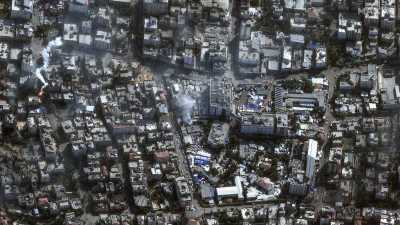‘Critical circumstances’: Israeli tanks outside Gaza hospital
Save articles for later
Add articles to your saved list and come back to them any time.
The news
Israeli tanks took up positions at the gates of Al Shifa hospital, Gaza City’s main medical facility, the primary target in Israel’s battle to seize control of the northern half of the Gaza Strip.
Israel says the hospital sits atop tunnels housing a headquarters for Hamas fighters using patients as shields, which Hamas denies.
Gaza health ministry spokesperson Ashraf Al-Qidra, who was inside Al Shifa hospital, said 32 patients had died in the past three days, including three newborn babies, as a result of the siege of the hospital and lack of power.
At least 650 patients were still inside, desperate to be evacuated to another medical facility by the Red Cross or some other neutral agency.
Al Shifa hospital has been without electricity and water for three days, and gunfire and bombings outside the compound “have exacerbated the already critical circumstances,” said World Health Organisation Director-General Tedros Adhanom Ghebreyesus said on Sunday, adding that the UN agency was in contact with the hospital.
Since Israeli ground forces entered Gaza in late October and quickly surrounded Gaza City, fighting has been concentrated in a tightening circle around Al Shifa.
Qidra said Israeli snipers and drones were firing into the hospital, making it impossible for medics and patients to move around.
Israel has told civilians to leave and medics to send patients elsewhere. It says it has attempted to evacuate babies from the neo-natal ward and left 300 litres of fuel to power emergency generators at the hospital entrance, but the offers were blocked by Hamas.
Elsewhere in the region:
- Fighting also took place at a second major hospital in northern Gaza, al-Quds, which has also stopped functioning.
- Israeli strikes killed two people in south Lebanon on Monday, according to a first-responder organisation affiliated with the Hezbollah-allied Amal Movement.
- A Hezbollah missile attack on Sunday wounded several workers from the Israel Electric Company with one later dying of his wounds, the firm said.
- US and international forces based in northeastern Syria were targeted at least four times in less than 24 hours with drones and rockets, a US military official said on Monday.
- Jordan’s foreign ministry says an evacuation is underway for 69 Jordanian citizens residing in Gaza who were allowed to leave through the Rafah crossing on Monday.
- The director of the UN agency for Palestinian refugees says all of the group’s aid operations in Gaza will cease in the next 48 hours unless fuel is allowed into the besieged enclave.
The human toll
- Since October 7, around 1200 Israelis have died and 240 were dragged to Gaza as hostages according to Israel’s tally. Gaza medical authorities say more than 11,000 people have been confirmed killed, around 40 per cent of them children.
The response
- The director of hospitals in Gaza, Mohammed Zaqout, said 36 newborn babies have not been evacuated from the hospital yet and there has been no coordination on moving them. He said there is no place to take patients, and called for the opening of a “safe passage” to take them to Egypt for treatment.
- German foreign minister Annalena Baerbock said she understands “the impetus for a cease-fire,” but questioned how those who seek one can guarantee Israel’s security in “this terrible situation” and wondered about the fate of the people Hamas has taken hostage.
- Israel’s foreign minister Eli Cohen told reporters on Monday that international pressure for a cease-fire is mounting and that Israel has a “window” of two to three weeks for continued operations in Gaza before pressure for a cease-fire intensifies.
- Israeli Prime Minister Benjamin Netanyahu on Monday described Hamas fighters as “simply savages” and vowed to press ahead till achieving “total victory.”
The Israel-Hamas conflict explained
- Tremors from the Hamas attacks and Israel’s response have reached far beyond the border. But what would all-out war in the Middle East look like?
- Hamas’ massacre in Israel has traumatised – and hardened – survivors. And in Gaza, neighbourhoods have become ghost cities.
- Inside the labyrinthine network of underground tunnels, which the Palestinian militant group has commanded beneath war-ravaged Gaza for 16 years. The covert corridors have long provided essential channels for the movement of weapons and armed combatants.
- As fears of the conflict expanding beyond Israel and Hamas steadily rise, all eyes are on Hezbollah. How did it form and what does Iran have to do with it?
Get a note directly from our foreign correspondents on what’s making headlines around the world. Sign up for our weekly What in the World newsletter.
Most Viewed in World
From our partners
Source: Read Full Article

